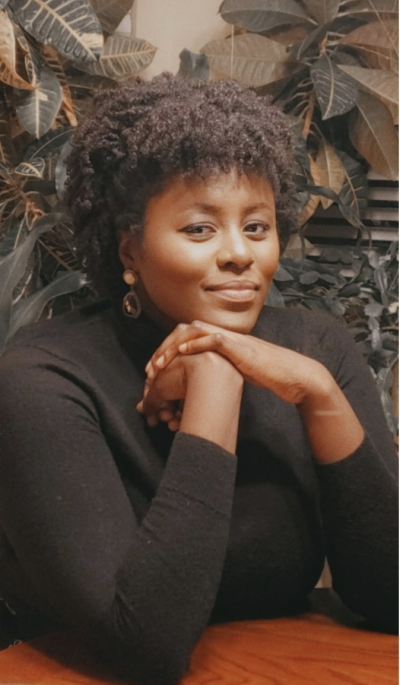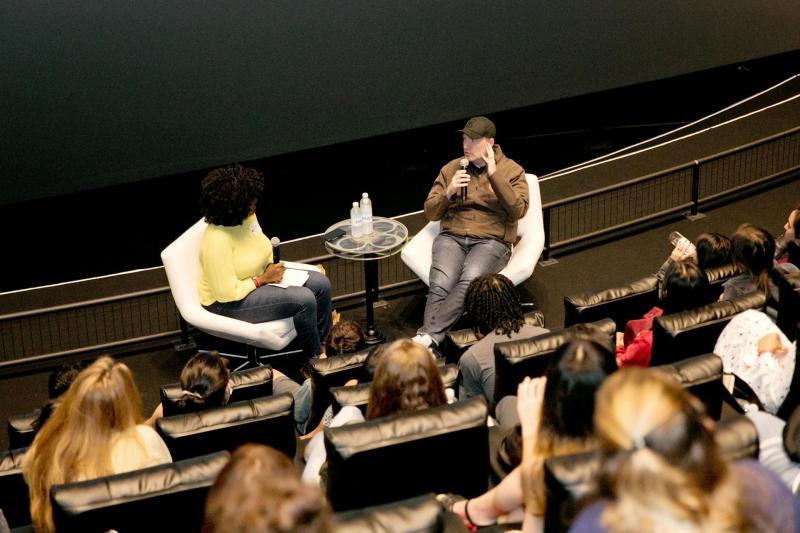February 25, 2022 | Alumni
'I'm doing it despite the fear': Rising filmmaker Nana Adwoa Frimpong on making space for Black women in film
Nana Frimpong on the set of her film, Healing in Color, with some of the film's cast. Photo courtesy of Nana Frimpong
Throughout her degree in English (minoring in Media Studies and Women’s Studies), a career in filmmaking wasn’t on Nana Adwoa Frimpong’s (BA 2018 UTSC) radar.
At U of T Scarborough, she had been an active organizer, becoming Vice-President, Equity for the Scarborough Campus Students’ Union. This year, Frimpong completes her MFA in filmmaking at the world-renowned University of Southern California (USC) in Los Angeles, California.

Frimpong articulates that she is “committed to directing, writing, and producing stories that illuminate the humanity of women, girls, and people of colour, while at the same time creating more opportunities for women to collaborate behind the camera.”
Her growing body of work illustrates these themes profoundly. Her short film, What Nina Said, about Black women and their experiences of misogyny, shame and liberation, was a finalist in the 2020 Women in Cinematic Arts Feminist Festival, for which she was awarded the USC John Huston Scholarship for Directing.
This year, Frimpong, who is also a George Lucas Scholar, was one of three USC students selected to produce a year-end showcase film. The resulting documentary, Healing in Color, lovingly looks at the role of art and community in Black women’s healing journeys.
In the U.S., the theme of Black History Month 2022 is "Black Health and Wellness." (Read more about Black History Month, its history and this year's events at U of T Scarborough.) The following conversation has been edited for clarity and length. UTSC will be celebrating with a screening of Healing In Color on March 1, which will be open to the UTSC community.
From UTSC to the U.S.A.
I came to Scarborough from Surrey, B.C. as a Business Management student in the International Business program. Within a year, I switched to English. So much of my degree informed what I’m doing now in film school, the skills I have to apply.
The degree I pursued at UTSC gave me the language for things that I always felt, or I wondered about, or was curious about. I remember hearing the Scarborough Campus Students’ Union (SCSU) VP of Equity speaking at my Orientation — which is what I later became. I realized that you can stand on a stage and declare who you are, stand in who you are proudly.
I’m always thinking about freedom, and what it means to exist in your skin and be unapologetic about it
That encouraged me to do the same thing. At first it was just me in the classroom, raising my hand. Those were baby steps that led me to doing bigger things at school.
But, I had never made a film when I came to film school.
There were many times when I was in Professor Sara Saljoughi’s Cinema Studies course at UTSC where I thought, ‘I can never make a film.’ But I trusted my imagination. I just don’t believe a vision would come to anybody if it didn’t have the ability to be actualized and realized. I’m doing it despite the fear.
I finished at UTSC in 2018, and then I started applying to film schools like U of T and NYU, as well as the University of Southern California.
I couldn’t get any information on the program or professors at USC, so I began approaching people on Linked In who were in the programs I wanted to apply to. For USC, the applications required me to write a script. I had never written a script before.
Then I was accepted to USC, and I thought: ‘Who’s going to pay for this? This is so expensive. This is a private U.S. institution.’
Two or three years prior to applying to film school, one of my uncles said, ‘I want you to watch these Ted Talks.’ One of them was by a woman by the name of Mellody Hobson. She was talking about being “colour brave.”
That was the first time I saw a Black woman on stage talk about her race, her identity, and how that plays into her work place. I would watch her Ted Talk every day. I just loved her. At that time, film school wasn’t even on my mind.
Fast forward to me being accepted at USC. My family and I were talking about how we could finance the MFA at USC when I got a letter. I was going to be the recipient of the George Lucas scholarship, which would give me funding for each year at USC. George Lucas is married to Mellody Hobson. I later learned that the scholarship is actually called the Hobson and Lucas Scholarship.
I encourage people to dream and reach out to people. I think everybody wants to help. There are a lot of good people who want to support you. I want to give a shout out to all the people at UTSC who supported me, in particular: Sara Saljoughi, Andrew DuBois, Jerry English, and Maria Assif. I still talk with them. They are my angels.
I’m just trying to create little pockets of space for the world to come over to Black women, because I think for so long we’ve had to come over to the world
Human stories and the role of art
I love documentary, because it is human stories. Once again, it speaks to my time at UTSC, because I had done a lot of organizing work for the SCSU, the Equity, Diversity and Inclusion Office, the Women and Trans Centre, and the African Students’ Association. That work was about hearing people’s stories, facilitating conversations, and empathizing with people.
Those are all things that documentary requires of you. As soon as I started, I felt it was more natural for me than fictional narratives. I don’t need to make up a story. I can just sit with people in their real stories.
Art is the way we’re able to connect with people in such deep, profound ways. It’s a mode of self-articulation. It’s a mode of record keeping. It’s a mode of healing. I think with Healing in Color in particular, what I hope people see or acknowledge in the film is that access to your emotions is not beyond you, and that vulnerability is strength.

The importance of Black women’s stories
There’s a Toni Morrison quote I always refer to: “I stood at the border, stood at the edge and claimed it as central. l claimed it as central, and let the rest of the world move over to where I was.”
I’m just trying to create little pockets of space for the world to come over to Black women, because I think for so long we’ve had to come over to the world. I didn’t have that language until I got to UTSC, where I realized there are ways that our media perpetuates images and stereotypes of Black women as being tough and angry.
You can be soft. You can be complex. I wanted to make films that would allow women that same freedom. I’m always thinking about freedom, and what it means to exist in your skin and be unapologetic about it.
For so long, there were not even enough spaces for Black women to be behind the camera. In terms of affirming, positive, complex, and nuanced representations, there really isn’t enough. Yet, there’s something about pointing a camera at somebody and saying, ‘You deserve to see this,’ that I think is revolutionary.
"The dance is between making another film and working for somebody"
The dance is between making another film and working for somebody. This is something that I’ve always struggled with, because women have been taught they aren’t supposed to say, ‘I want to be the leader. I want to be the director.’ I feel like women are constantly told you’re supposed to be the gal beside the guy.
My dream would be to go back to my community and create some type of hub or creative incubator space, something in the community where people could come and hear from filmmakers, work with people who are in the industry, and watch movies.
My ultimate dream is to create a space where I can direct and write my own stuff, but then also be able to support other artists. The idea is that someone could come to me and say, ‘I have this idea but I don’t have money,’ or ‘I want to show my film so I can get feedback on it.’ I’d love my team and I to be able to facilitate that financially and give space to other artists.

